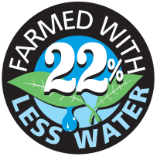
Posted on : August 16th, 2016
 Saving water is always in the forefront of our minds. The topic has been getting a lot more focus in the midst of California’s drought. We believe in doing our part to save our most valuable and natural resource by practicing holistic land management and investing in new technological approaches. Maisie Jane’s water-wise practices will use 22% less water.
Saving water is always in the forefront of our minds. The topic has been getting a lot more focus in the midst of California’s drought. We believe in doing our part to save our most valuable and natural resource by practicing holistic land management and investing in new technological approaches. Maisie Jane’s water-wise practices will use 22% less water.
Maisie Jane’s works hard to promote Small Family Farming as sustainable for the earth and future generations by using less:
Less Water Use = Healthier Farmland
Measuring up the water use with water being one of the most precious resources in Californian, people are talking more than ever about how to be more efficient with its use.
Unfortunately, almonds have become targeted in an alarming misconception born of these discussions; growing almonds uses 10% of California’s water.
 That’s far from the truth. It’s actually only 9% of the state’s managed agricultural water, as shown in the diagram on the right.
That’s far from the truth. It’s actually only 9% of the state’s managed agricultural water, as shown in the diagram on the right.
Although almonds occupy 13% of California’s irrigated farmland, they use only 9% of California’s agricultural (not total) water, less than their proportionate share.
Actually, almonds are not an especially “thirsty” crop. Almond trees use roughly the same amount of water as all other California fruit and nut trees.
California’s Mediterranean climate, with its cool wet winters and hot dry summers, offers ideal growing conditions for many diverse crops. California’s top ten crops in acreage are hay, almonds, grapes, wheat, corn, rice, walnuts, cotton, tomatoes and pistachios. And they all need water to grow.
The water almond trees use provides more than just almonds. Almond by-products don’t go to waste. The fuzzy green outer hulls feed dairy cows, while the harder inside shells are used for energy production through cogeneration and as livestock bedding.
Almond firewood is also in high demand.
An ideal climate, combined with rich soil, water infrastructure, innovative technology, and research, makes California the most productive almond-growing region in the world.
California produces 100% of the U.S. domestic supply of almonds and generates more than 100,000 California jobs.
For more than 100 years, Californians have been developing water infrastructure to effectively capture and transport surface water for use throughout the year and to store for dry years.
While a majority of California’s precipitation falls in the north of the state, it is moved through a network of canals and aqueducts to urban population centers and agricultural land.
All Californians, not just those in agriculture, rely on water captured and stored during wet winter months to access in dry summer months.
Despite population growth and decreased acreage dedicated to agriculture, the production of California agriculture has continually increased.
Bottom line, California farmers will continue to evolve, innovate and regulate their crops, to bring more food, grown with less water, to your table.
And that’s worth talking about!